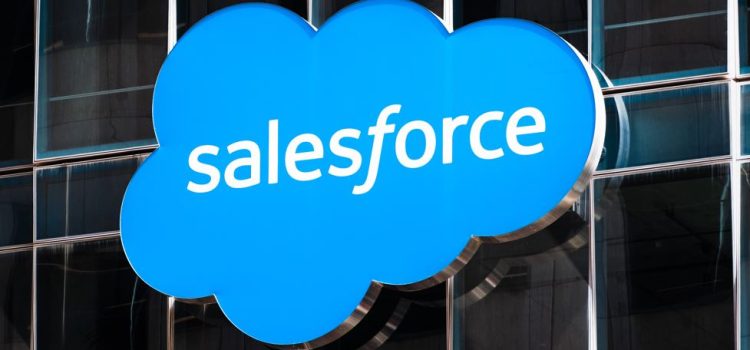
Marc Benioff didn’t just build another software company—he revolutionized how businesses access and use technology by pioneering the “Software-as-a-Service” model that now powers a $150 billion industry.
In Behind the Cloud, Salesforce founder Marc Benioff reveals how he transformed enterprise software from expensive, months-long installations into simple web-based tools that companies could start using immediately for a monthly subscription fee. Benioff shares how Salesforce survived the dot-com crash, converted users into evangelists, and scaled globally while maintaining its revolutionary culture. Here’s our book overview.
Behind the Cloud Book Overview
Most people recognize Salesforce (formerly salesforce.com) as one of the world’s most valuable technology companies, but few understand what it does. Salesforce provides customer relationship management (CRM) software: tools that help businesses track potential customers, manage relationships, and forecast sales. In Behind the Cloud (2009), Salesforce founder Marc Benioff explains how his company pioneered the “Software-as-a-Service” (SaaS) model in the 1990s, transforming business software from tools that took months to install into simple web-based platforms that were accessible from anywhere, automatically updated, and priced affordably. This vision created an entirely new industry worth over $150 billion today.
Benioff brought both technical expertise and sales experience to the challenge of reimagining enterprise (business-systems) software. After studying business administration at the University of Southern California, he joined Oracle in 1986 as a customer support representative, eventually rising to become the youngest vice president in the company’s history by age 27. During his 13 years at Oracle, Benioff learned from founder Larry Ellison about building enterprise software companies, but he also witnessed the limitations of traditional software. In 1996, he hit upon the idea that would become Salesforce during a period of reflection about his career direction.
Benioff co-wrote Behind the Cloud with journalist Carlye Adler to look back on what it took to build his company. In this guide, we’ll explore the foundational innovation that made everything possible, the market positioning that created an entirely new category of enterprise software, and the growth strategies and leadership approaches that enabled Salesforce to scale into a global enterprise. Along the way, we’ll provide context on how the SaaS revolution Benioff pioneered has evolved, explore the strategic logic behind category creation that other revolutionary companies have used, and examine what Salesforce’s AI transformation reveals about maintaining entrepreneurial culture during technological disruption.
What Benioff Set Out to Change About the Software Industry
When Benioff and his cofounders launched Salesforce in 1999, they didn’t set out to just build another software company: They wanted to challenge fundamental assumptions about how enterprise software—the software used by large organizations—should work for the businesses buying and using it. Benioff and Adler explain that this required innovations in technology, business, and customer relationships that would reshape the entire industry.
From Oracle Executive to Cloud Computing Pioneer
Benioff’s vision for Salesforce grew from years of watching customers struggle with Oracle’s traditional software model. During his 13 years at Oracle, where he rose to become the youngest vice president in company history by age 27, Benioff witnessed the limitations and frustrations of how enterprise software was delivered to businesses. In 1996, feeling professionally successful but personally unfulfilled, Benioff took a sabbatical to gain perspective. During this period of reflection, while he was swimming with dolphins in Hawaii, the inspiration for what would become Salesforce crystallized in Benioff’s mind.
Benioff envisioned delivering business software through what would later be called “cloud computing”—software that would live on remote servers and could be accessed through the internet from anywhere. This vision was so compelling that Benioff eventually left Oracle to pursue it. When he was ready to turn his idea into reality, a conversation with entrepreneur Bobby Yazdani proved pivotal. Yazdani introduced him to three developers, Parker Harris, Dave Moellenhoff, and Frank Dominguez, who had the combination of experience in enterprise software and internet application to make cloud computing work for businesses.
Benioff and his cofounders launched Salesforce in 1999, initially working from a one-bedroom apartment in San Francisco. By that summer, the team had grown to 10 employees and moved to a larger office, but the mission remained unchanged: to prove that business software could be delivered as simply and reliably as the websites people used to check email or shop online.
Why Traditional Enterprise Software Was Broken
Benioff and Adler explain that prior to the cloud computing model, the enterprise software industry of the 1990s had systemic problems that made powerful business tools inaccessible to most companies. The primary issues were complexity and cost. The traditional model worked like this: Enterprise software companies sold their applications as products. Customers paid large upfront fees (typically hundreds of thousands of dollars), then spent months or years implementing the software with help from consultants and IT specialists. Once it was installed, companies owned the software but were responsible for maintaining their own servers, managing updates, and troubleshooting problems.
The software installation process required companies to purchase expensive hardware, hire consultants to customize the software, and dedicate internal IT resources for months of configuration work. Many of the associated software licenses were never activated because companies found the implementation process too daunting or expensive to complete. Even when the software installation was successful, ongoing maintenance created more burdens. Every update required careful planning, testing, and coordination to avoid disrupting operations. Many companies fell behind on updates entirely, leaving them with outdated systems that couldn’t take advantage of new features or security improvements.
How Software-as-a-Service Changed Everything
Benioff’s solution was to deliver business software as a subscription rather than as a licensed product that customers purchased outright. This approach, which became known as Software-as-a-Service (SaaS), was part of his vision for cloud computing—the idea that software could run from a “cloud” of internet servers rather than on individual companies’ computers. Instead of buying expensive software that required dedicated IT teams to install and maintain, businesses could log into a website and start using powerful applications for a monthly fee. The architecture that made this possible was called “multitenancy,” a system where multiple people could use the same application, with their data separate and secure.
Salesforce’s approach to selling software as a service offered compelling practical advantages. Because all of the company’s customers used the same underlying application, Salesforce could deliver new features through updates to their central servers, and all customers could access the latest version of the software automatically, without a painful upgrade process. The subscription model also aligned Salesforce’s success with their customers’ success in a new way: Instead of collecting upfront fees for maintenance, Salesforce only earned subscription fees when customers found ongoing value in the service. This created incentives to ensure the software actually worked well and delivered results.
According to Benioff and Adler, the scalability of SaaS was revolutionary as well. Traditional software required each customer to purchase and maintain their own servers and hardware. With the SaaS model, Salesforce could achieve economies of scale by serving thousands of customers from shared infrastructure, dramatically reducing the total cost of computing resources. This approach democratized access to sophisticated business software: Small companies could use the same powerful CRM capabilities as large enterprises for a monthly fee equivalent to what they might spend on office supplies. This leveled the competitive playing field and opened enormous new markets that traditional software vendors had ignored.
Why Presenting Salesforce as Revolutionary Was Essential
After establishing the technical foundation that made SaaS possible, Benioff and his cofounders faced an equally challenging problem: How would they convince an entire industry to abandon its familiar approaches for something radically different? Benioff and Adler explain that the choice to present Salesforce as revolutionary wasn’t just marketing bravado—it was strategic. In this section, we’ll explore why the authors believe that more moderate messaging would have failed and how Salesforce’s approach was essential for its success.
Why Salesforce Had to Define an Entirely New Category
When Benioff and his cofounders launched Salesforce, they faced a critical choice: They could market themselves as offering better software or as representing something entirely new. They chose the more radical path, declaring Salesforce the herald of “the end of software.” If Salesforce had presented itself as “better CRM software,” customers would have compared it to existing solutions using familiar criteria: features, customization options, and enterprise-grade capabilities. On these traditional measures, Salesforce’s early web-based application couldn’t match the sophisticated functionality that other companies had developed over the years.
Other software vendors had taught customers to see expensive implementations and customizations as a plus, but Salesforce needed to convince them that simplicity, speed, and accessibility were superior. Benioff saw that being first to deliver enterprise software as a service would let Salesforce define this new category and establish the criteria by which future products would be judged. Instead of competing on traditional metrics, Salesforce emphasized advantages like instant accessibility, automatic updates, and pay-as-you-go pricing. So when Salesforce adopted the slogan “no software,” it wasn’t just promoting its benefits—it was reframing software installation, maintenance, and ownership as burdens rather than assets.
How Salesforce Positioned Itself as Revolutionary
Having determined that revolutionary messaging was essential, Benioff and his cofounders launched a systematic campaign of confrontational marketing tactics designed to break through established ways of thinking about enterprise software. The campaign began with Salesforce’s distinctive branding. Benioff hired marketer Bruce Campbell to create the “No Software” logo—the word “software” enclosed in a red circle with a line through it, like a prohibition sign. Despite internal skepticism about using negative messaging, Benioff insisted the logo clearly communicated how Salesforce differed from traditional software companies.
Salesforce soon escalated to direct confrontation with its competitors. It staged mock protests outside Siebel conferences that marketed CRM software, hiring actors to wave “No Software” signs while distributing invitations to Salesforce launch parties. Benioff and Adler explain that these guerrilla marketing tactics served a crucial purpose: They forced people to choose between the old way and the new way rather than defaulting to familiar solutions. The company treated market leader Siebel not as a competitor to avoid mentioning, but as a foil that helped define what Salesforce represented. By contrasting themselves against Siebel specifically, they could highlight the most problematic aspects of traditional software while demonstrating their own advantages.
How Crisis Management Validated Their Approach
The authors reveal that the dot-com crash of 2001 provided an unexpected test of Salesforce’s messaging and business model. When the technology bubble burst, many internet startup customers either reduced their use of Salesforce’s platform or failed entirely, leaving Salesforce facing potential bankruptcy with monthly losses of $1 million to $1.5 million. This crisis forced a pivot that ultimately validated their approach. Board member Magdalena Yesil proposed shifting from monthly billing to annual contracts with upfront payment, addressing Salesforce’s cash flow problem.
Despite initial team resistance to this change—which seemed to contradict their “low-risk, pay-as-you-go” messaging—more than 50% of customers immediately agreed to the new terms. The authors explain that this loyalty during the dot-com crisis demonstrated the strength of the relationships Salesforce had built through its customer-first approach. Unlike traditional vendors who collected large upfront fees and then provided maintenance, Salesforce had built trust by continuously improving its service based on customer feedback, delivering automatic updates, and aligning its success with customer success through the subscription model.
Benioff contends that Salesforce’s successful transition proved that the company’s revolutionary messaging had created genuine value rather than being a mere marketing tactic. Customers chose to commit to Salesforce because they had experienced real benefits, validating Benioff’s belief that revolutionary messaging must be grounded in innovation. The crisis also reinforced the importance of Salesforce’s aggressive differentiation strategy. While many dot-com companies failed because they couldn’t clearly articulate what value they provided, Salesforce’s clear messaging as “the end of software” gave a compelling reason for customers to maintain their commitment even during economic uncertainty.
How Salesforce Came to Dominate the CRM Market
Salesforce’s revolutionary messaging had created the conceptual framework for success, but messaging alone doesn’t build sustainable businesses. By 2002, the company had survived the dot-com crash and proven that customers valued its approach. But surviving the crisis was only the beginning—the real challenge was scaling from a scrappy startup to the industry giant that could fulfill its promise of transforming enterprise software. Benioff and Adler explain that Salesforce accomplished this through customer-driven approaches to growth strategies and systematic methods for maintaining its culture while expanding globally.
The Company Turned Its Users Into Evangelists
First, Benioff and Adler explain that Salesforce grew by converting users into active advocates who would promote Salesforce within their organizations and to their professional networks. The company made the unconventional choice to market directly to end users—sales, marketing, and customer support professionals—rather than to the executives who typically controlled software budgets. As Salesforce expertise became a valued skill in the job market, employers began seeking candidates with platform experience, while workers highlighted Salesforce experience as a career differentiator. This created network effects that drove more companies to adopt Salesforce as their CRM provider.
Salesforce also transformed satisfied customers into active sales representatives at its “City Tour” events, mixing existing customers with prospective clients. Because the month-to-month payment model ensured continuing customers were genuinely satisfied, these customers would spontaneously share their experiences with peers who were considering Salesforce. Benioff and Adler say these events achieved 80% conversion rates, since prospective clients trusted their peers’ experiences more than any presentation Salesforce could have made.
Salesforce Evolved From an Application to an Ecosystem
Second, customer feedback drove a significant strategic evolution: transforming Salesforce from a single application provider to a comprehensive platform. Benioff and Adler explain that as users requested capabilities beyond basic CRM, Salesforce faced a choice between building every possible application internally or creating infrastructure that would allow other companies to build solutions on its foundation. Salesforce chose the platform approach, developing Force.com as a complete development environment and AppExchange as a marketplace where customers could discover and purchase additional applications.
The authors say this strategy satisfied customer demands for more functionality while creating new revenue streams. Plus, as customers built custom features and tailored the system to their specific processes, they became increasingly unlikely to switch to competitors. The switching costs weren’t just financial: They involved rebuilding entire workflows and losing years of customizations. The platform strategy also enabled Salesforce to benefit from other companies’ innovations. Third-party developers expanded Salesforce’s capabilities while strengthening the ecosystem’s value. This created a virtuous cycle: More applications attracted more customers, which attracted more developers, who created more applications.
Salesforce Scaled Globally While Preserving Its Culture
After establishing sustainable growth through customer evangelism and platform expansion, Salesforce faced a final scaling challenge: becoming a global enterprise without losing sight of its original culture and values. Benioff and Adler explain that the company developed systematic ways to preserve its culture, maintain its focus, and expand internationally.
Integrated Philanthropy as Cultural Foundation
Benioff and Adler explain that Salesforce’s 1-1-1 philanthropy model helped preserve company culture during global expansion. From the beginning, the company committed to donating 1% of its equity, 1% of employee time, and 1% of its product to charitable causes. In practice, this meant that employees received six paid volunteer days per year, nonprofits could access Salesforce’s platform for free, and the company established a foundation focused on bridging the digital divide for underserved youth.
According to the authors, this approach created practical advantages as Salesforce expanded globally: It helped the company attract employees who wanted meaningful work, and it provided a consistent set of values that remained the same regardless of location. The 1-1-1 model’s influence on other companies, including Google’s adoption of similar approaches, established Salesforce as a thought leader that employees felt proud to represent internationally.
The V2MOM System for Global Alignment
Benioff developed the V2MOM management system—Vision, Values, Methods, Obstacles, and Measures—to keep everyone at Salesforce aligned as the company expanded. This framework works as both a planning tool for leaders and a way to communicate priorities throughout the company. The authors describe V2MOM as a living document that gets updated every six months with input from senior leadership. Each employee creates their own V2MOM that connects to the companywide version, so that everyone’s goals tie directly to what the company wants to achieve. This system can adapt to new opportunities while keeping everyone focused on the same core priorities, wherever they work.
Salesforce’s Global Expansion Strategy
Benioff and Adler explain how Salesforce approached international expansion by maintaining specific core practices while adapting to local contexts. This meant preserving their customer-first approach, the V2MOM system, and the 1-1-1 philanthropy model, while hiring native speakers and adjusting marketing tactics for local markets. Expansion required what Benioff and Adler call “missionary” leadership—sending experienced executives with deep knowledge of these core practices to establish new markets. For example, when expanding to Europe, Salesforce sent leaders who could implement the same event-driven marketing, end-user focus, and customer feedback systems that had worked in the US.
Benioff and Adler emphasize that Salesforce’s approach to global growth required genuine long-term commitment: establishing local offices, building relationships with local partners, and investing in community programs that reflected their philanthropic values, rather than simply opening sales branches.






